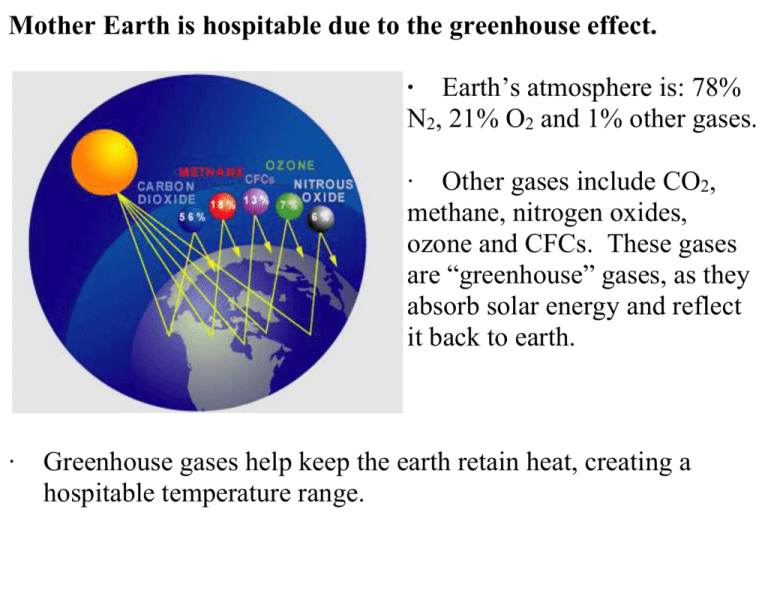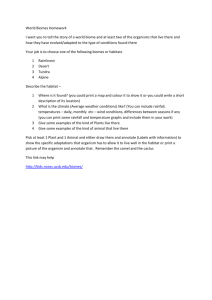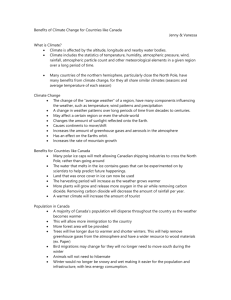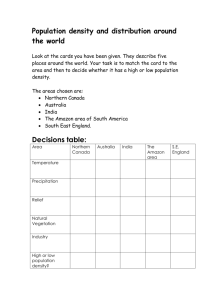02 KM Lecture - Biogeography
advertisement

Mother Earth is hospitable due to the greenhouse effect. ∙ Earth’s atmosphere is: 78% N2, 21% O2 and 1% other gases. ∙ Other gases include CO2, methane, nitrogen oxides, ozone and CFCs. These gases are “greenhouse” gases, as they absorb solar energy and reflect it back to earth. ∙ Greenhouse gases help keep the earth retain heat, creating a hospitable temperature range. Earth’s Climate is Variable: There are 7-10 different biomes. ∙ Each biome has a distinct climate pattern (seasonal vs. constant rainfall and temperature pattern), productivity, population density and contains similar flora/fauna/food webs. $ What causes the pattern of biomes throughout the world? Climate Basics: Biome patterns are explained by geological factors: The earth’s tilt and rotation about the sun, latitude, altitude, proximity to bodies of water or mountain ranges. ∙ The earth is tilted on its axis. Equatorial regions have consistent sunlight and temp. patterns. ∙ Northern and southern hemispheres experience summer (when tilted toward the sun) and winter (when tilted away from the sun) with variable temperature patterns. They have cold winters and warm summers. Consistent heat in equatorial latitudes drive the earth’s air circulation patterns. ∙ At the equator, most of the earth’s surface is water. ∙ Temperatures are always warm, and the warm air rises consistently. ∙ Air cools as it rises, condensing to produce heavy rain that is typical of tropical climates. ∙ This is known as the Hadley convection cell, and its consistent pattern drives air circulation across our planet. The mid-latitudes experience distinct winter and summer weather patterns and have a highly variable rainfall pattern. ∙ Air from the Hadley cell descends at 30 oN and 30 oS. This air warms as it nears earth, and its saturation point increases. Thus, little rainfall occurs and the world’s great deserts are typically found at 30 oN and 30 o S. ∙ Air rises again at 60 oN and 60 oS, so regions in between 30o and 60o experience moderate seasonal rainfall. This circulation pattern is known as the Ferrel cell. ∙ In these latitudes, presence of mountain ranges and/or proximity to water cause highly variable rainfall and temperature patterns. Polar regions have short summers, long winters and the cold air holds little moisture before reaching saturation. ∙ The most northern and southern air cell is called the polar cell. Polar regions have very little precipitation, mostly in the form of snow. ∙ Cold temperatures allow permanent ice caps to persist. ∙ Polar ice is a critical component of earth’s climate: it reflects sunlight and helps to counter-balance the greenhouse effect. This phenomenon is known as albedo. Within each air cell, mountain ranges, altitude and large bodies of water influence the basic temperature and rainfall patterns. ∙ High altitude biomes generally have cooler temperatures and may block wind patterns, thus limiting rainfall. ∙ Coastal regions have moderation of winter and summer temperatures as well as additional moisture. ∙ Here is an example of the orographic effect: the impact of mountain range placement on precipitation. Note that Reno and Sacramento have less rainfall than the Bay Area, because they are on the leeward (sheltered) sid e of the mountains.








